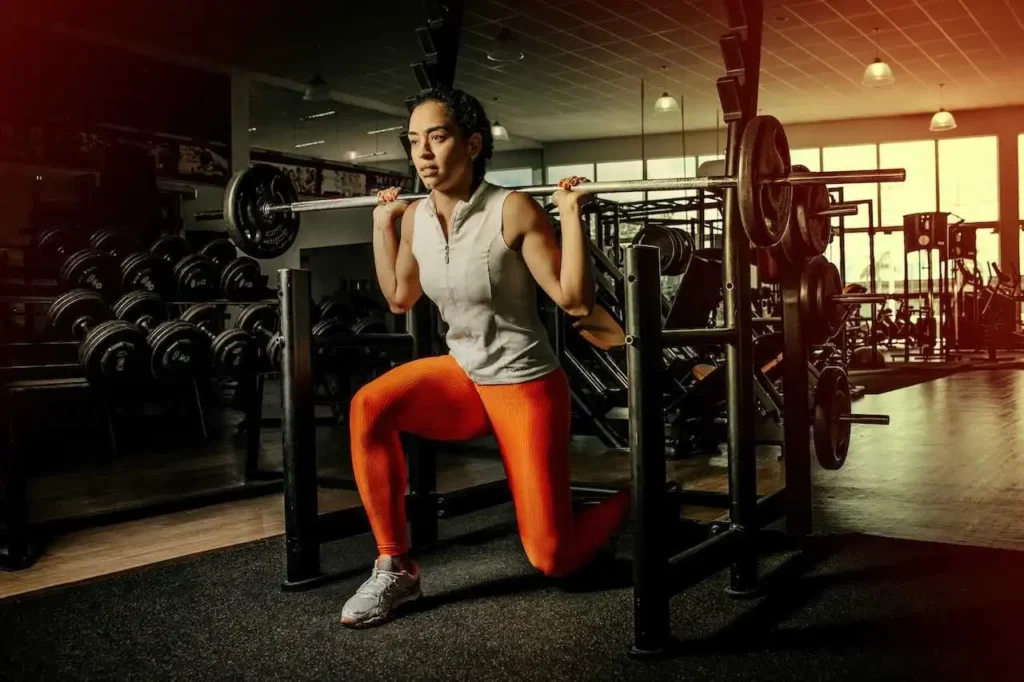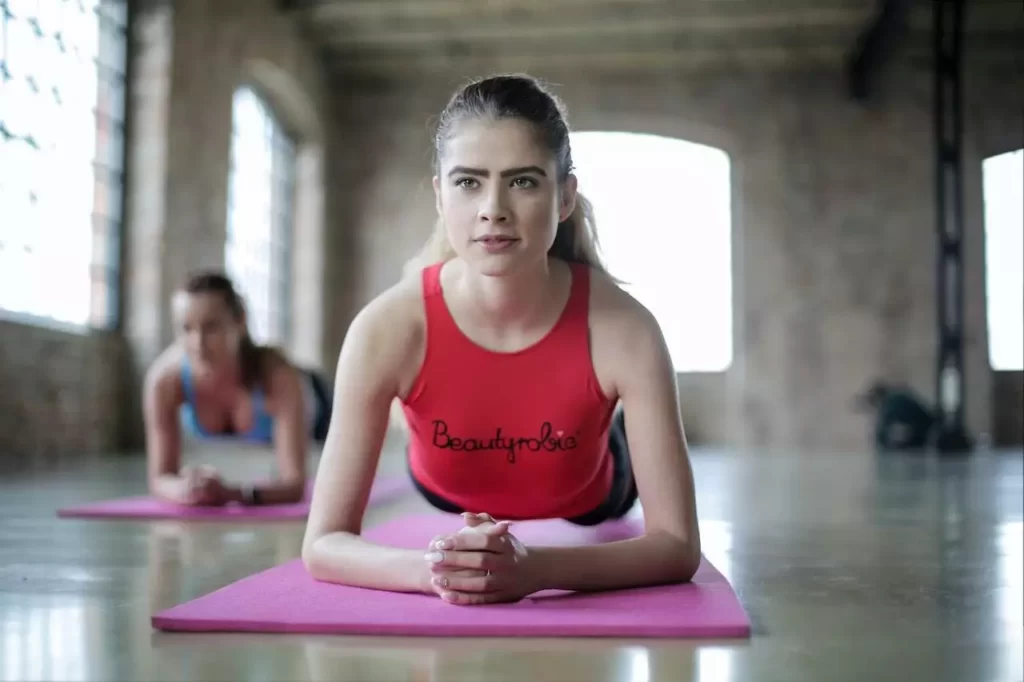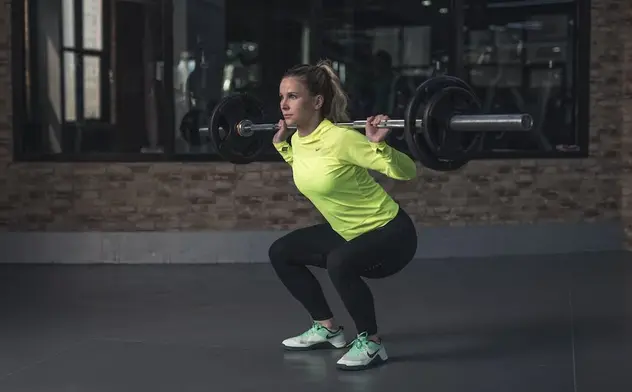Muscle building only works with heavy weights in the studio? Are you kidding me? Are you serious when you say that!
The living room can also become a power corner. There you can even train completely independently and flexibly.
The cheapest and simplest variant: You just buy a mat and train with your own body weight – you do a pure body weight training.
If you want to make your workout more varied and see progress faster, you can buy a few devices. The basic equipment includes:
Optionally, depending on your needs and requirements, you can also get a barbell set, a pull-up barkettlebell, punching bag and slam ball purchase.
No matter what you choose, we’ll show you the best muscle building exercises to do at home – with and without equipment.
Training at home: exercises without equipment
It doesn’t matter whether you want more muscles or more strength as a training goal, e.g To perform calisthenics better, you have: The best exercises for beginners and advanced users.
Squat

| Trained: | Legs, buttocks, core |
|---|---|
| Note: | Stomach tight, weight on complete foot, knees stay at ankle level |
Mar10

| Trained: | arms, shoulders, back |
|---|---|
| Note: | Belly firm, shoulders pulled back and down, head in extension of the spine |
Plank

| Trained: | abdomen, back, shoulders |
|---|---|
| Note: | Push heels back, stomach tight, shoulders over wrists |
FIT FOR FUN/Cult Models
| Trained: | abdomen, back, shoulders |
|---|---|
| Note: | Push heels back, stomach tight, shoulders over wrists |
Barbell Squats

| Trained: | Buttocks, Legs, Core |
|---|---|
| Note: | Stomach tight, chest out, knees at ankle level, go just low enough to keep your heels on the ground |
For beginners: Use a heel raiser if your feet lift off the floor as you move down.
lunges
| Trained: | thighs, abdomen, back |
|---|---|
| Note: | Firm stomach, pull shoulders back and down, rotate front knee slightly outwards |
| Trained: | thighs, abdomen, back |
|---|---|
| Note: | Firm stomach, pull shoulders back and down, rotate front knee slightly outwards |
Alternative gear: You can also do the exercise with dumbbells, barbells or without additional weights.
Deadlift
| Trained: | back, abdomen, thighs, buttocks |
|---|---|
| Note: | Back stays straight, legs slightly bent, movement comes from the pelvis |
| Trained: | upper arms |
|---|---|
| Note: | Pull shoulders back and down, feet planted on floor, wrists straight |
For advanced: Vary the grip and angle of the bench. You can find even more tips in our bench press tutorial.
Push-ups with rows
| Trained: | Upper arms, shoulders, abdomen, back |
|---|---|
| Note: | Stomach firm, shoulders at wrist level, heels pressed back, body in a straight line |
| Trained: | Upper and lower back, buttocks |
|---|---|
| Note: | Neck relaxed, head in line with spine, stomach firm |
| Trained: | abdomen, shoulders, back |
|---|---|
| Note: | Head in extension of spine, shoulders over wrists, stomach tight |
Bodyweight vs. Dumbbells: Pros and Cons
Training with your own body weight has its advantages – but so does training with dumbbells or barbells. A brief overview:
Pros and cons of bodyweight training
If you only train at home with your own body weight, it is very inexpensive – apart from a one-time, manageable investment in a training mat, you have no further costs.
In addition, the workout can be carried out anywhere – at home, on the road, in the hotel and, when the weather is nice, outside as well.
Bodyweight training generally involves a low risk of injury, since ligaments, tendons and joints are not heavily loaded. An exception here are demanding exercises, for example from the Calisthenics.
Bodyweight training at home saves a lot of time, since there are no long ways to the studio and then back home.
In addition, the training is technically demanding despite its simplicity – some exercises require more intramuscular coordination than equipment training. For example, a push-up is more difficult for your body to coordinate than pressing a barbell. Over time, this has a positive effect on the functional abilities of your musculoskeletal system.
However, bodyweight training offers only limited opportunities to increase – to increase the resistance, you can change the lever and angle or the position of your body in space, e.g. B. by elevating your feet when doing a push-up, make it significantly more difficult.
At some point, however, there are limits to resistance. Increasing the training pace is also only of limited benefit for building muscle – for this you have to do plyometric exercises that improve your explosive power, such as box jumps from a deep squat position.
Pros and cons of dumbbell training
With variable dumbbell sets, you have small and large weight plates at your disposal, so you can dose the training resistance better and increase it in small steps.
Plus, your progress is easy to track—when you’re training and suddenly you’re able to do dumbbell bicep curls with 30-pound dumbbells instead of 10, that’s a simple way to know that you’ve gained strength and that your muscle growth is on the right track .
However, the risk of injury when training with dumbbells is significantly higher. Especially newcomers who don’t have the movement control they need and who start out with excessive free weights can potentially catch strains and worse.
In addition, you are stationary during dumbbell training, after all nobody drags their dumbbells and barbells with them or moves the training to the park.
